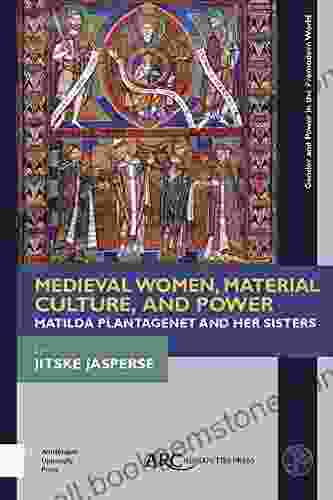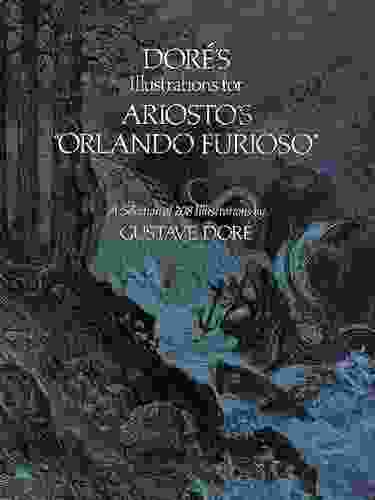How an Elusive 16th Century Artist Became a Global Pop Icon

4.2 out of 5
| Language | : | English |
| File size | : | 7506 KB |
| Text-to-Speech | : | Enabled |
| Screen Reader | : | Supported |
| Enhanced typesetting | : | Enabled |
| Word Wise | : | Enabled |
| Print length | : | 267 pages |
In a world obsessed with images, Giuseppe Arcimboldo stands as an enigmatic figure, a pioneer of surrealism centuries before the movement emerged. His bizarre and captivating portraits, composed entirely of fruits, vegetables, and flowers, have mesmerized audiences for over five centuries. From royal courts to modern-day art galleries, Arcimboldo's work has transcended time and mediums, becoming a global pop icon.
Early Life and Training
Born in Milan, Italy in 1527, Giuseppe Arcimboldo's early life remains shrouded in mystery. It is believed that he studied painting under his father, Biagio Arcimboldo, a minor artist. By the age of 22, he had established himself in Milan as a skilled portraitist. However, it was not until his fateful encounter with Emperor Maximilian II in 1562 that his career took a dramatic turn.
Imperial Patronage and Grotesque Portraits
Maximilian II, known for his eccentric tastes, commissioned Arcimboldo to create a series of allegorical portraits. These works, known as "grotesque heads" or "composed heads," featured human faces constructed entirely from plants and animals. The emperor was so impressed by Arcimboldo's ingenuity that he appointed him court painter in 1563.
Artistic Techniques and Symbolism
Arcimboldo's grotesque portraits were not merely whimsical creations. They were complex allegories that conveyed hidden meanings and celebrated imperial virtues. The artist's meticulous attention to detail and his mastery of chiaroscuro created a sense of hyperrealism that blurred the line between nature and representation. Fruits and vegetables became eyes, leaves formed beards, and flowers adorned headdresses.
Each element in Arcimboldo's compositions carried symbolic significance. For example, the artichoke, with its spiky exterior, represented wisdom and protection; the wheat symbolized fertility and abundance; and the vine leaves evoked the triumph of Bacchus, the Roman god of wine.
Artistic Innovation and Influence
Arcimboldo's innovative portraits pushed the boundaries of artistic expression. He broke away from the prevailing conventions of Renaissance portraiture, embracing a surrealist aesthetic that would later inspire generations of artists, including Salvador Dalí and René Magritte.
Arcimboldo's influence extended beyond the art world. His grotesque heads were reproduced on tapestries, prints, and even ceramics. They became objects of fascination for scholars, collectors, and the general public.
Rediscovery and Modern Reinterpretation
After falling into relative obscurity during the 18th and 19th centuries, Arcimboldo's work underwent a remarkable resurgence in the 20th century. The advent of Surrealism and Dadaism renewed interest in his bizarre and dreamlike imagery.
In recent years, Arcimboldo's paintings have been exhibited in major museums around the world. His work has been reinterpreted through contemporary photography, fashion, and even culinary arts. From haute couture gowns to experimental dishes, Arcimboldo's influence continues to inspire and challenge artists and designers across disciplines.
Giuseppe Arcimboldo's enigmatic and unforgettable portraits have secured his place as a global pop icon. His surrealist vision, blending nature and representation, has fascinated audiences for centuries. From imperial courts to modern-day galleries, Arcimboldo's work continues to evoke wonder, inspire creativity, and challenge our perceptions of reality. As his legacy endures, the elusive 16th century artist remains a testament to the enduring power of art to transcend time and connect with the human imagination.
4.2 out of 5
| Language | : | English |
| File size | : | 7506 KB |
| Text-to-Speech | : | Enabled |
| Screen Reader | : | Supported |
| Enhanced typesetting | : | Enabled |
| Word Wise | : | Enabled |
| Print length | : | 267 pages |
Do you want to contribute by writing guest posts on this blog?
Please contact us and send us a resume of previous articles that you have written.
 Best Book
Best Book Page Flip
Page Flip Bookshelf
Bookshelf Literary loom
Literary loom Chapter
Chapter Bookish
Bookish PageTurner
PageTurner Bibliophile
Bibliophile Story
Story Inkwell
Inkwell Bookworm
Bookworm Labyrinth
Labyrinth Plot Twist
Plot Twist Prose
Prose Paperback
Paperback Storyteller
Storyteller Sanctuary
Sanctuary Fiction
Fiction Reading
Reading Chronicle
Chronicle Read
Read Miss Jazzie
Miss Jazzie Neil Lancaster
Neil Lancaster Nick Hunt
Nick Hunt Nichole Perkins
Nichole Perkins Dennis Banks
Dennis Banks Lisa Rose Wright
Lisa Rose Wright Michael R Pitts
Michael R Pitts Tom Ryan
Tom Ryan Jill Culiner
Jill Culiner Ellen Murkison
Ellen Murkison Luigi Amara
Luigi Amara Roberta Carter Clark
Roberta Carter Clark Sari Botton
Sari Botton Peter F Drucker
Peter F Drucker Jonathan Green
Jonathan Green John Dominic Crossan
John Dominic Crossan Ellen Winner
Ellen Winner Michael Arndt
Michael Arndt Ronald Malfi
Ronald Malfi Ellen Grady
Ellen Grady Michael Dante Dimartino
Michael Dante Dimartino Wilfrid Jonson
Wilfrid Jonson Tulku Thondup
Tulku Thondup Skywatcher Press
Skywatcher Press Joey Korenman
Joey Korenman Malcolm X
Malcolm X Jane Maday
Jane Maday Mulk Raj Anand
Mulk Raj Anand Elizabeth Bear
Elizabeth Bear Elizabeth Mowry
Elizabeth Mowry Lea Rawls
Lea Rawls Francesco Lo Iacono
Francesco Lo Iacono Eric Rickstad
Eric Rickstad Laurence Maslon
Laurence Maslon E M Forster
E M Forster Tarana Burke
Tarana Burke Joy Deja King
Joy Deja King Michel Prince
Michel Prince Wendy Lesser
Wendy Lesser Dima Zales
Dima Zales Jennifer Clement
Jennifer Clement Luca Turin
Luca Turin Bruce Cook
Bruce Cook Janet Wilcox
Janet Wilcox Robert Ullian
Robert Ullian Hillary Kerr
Hillary Kerr Don Peri
Don Peri Kale James
Kale James T C Edge
T C Edge Geniuz Gamer
Geniuz Gamer Edward Chisholm
Edward Chisholm Victoria Lewis
Victoria Lewis Ruth Wilshaw
Ruth Wilshaw Dessy Tsolova
Dessy Tsolova Kevin Brownlow
Kevin Brownlow Roz Marshall
Roz Marshall Mike Yoshiaki Daikubara
Mike Yoshiaki Daikubara E B Dawson
E B Dawson Elle Wright
Elle Wright Nina Garcia
Nina Garcia Rory Moulton
Rory Moulton Helene Cixous
Helene Cixous Kassanna
Kassanna Emma Block
Emma Block Rosie Mercado
Rosie Mercado L D Goffigan
L D Goffigan Frank Right
Frank Right Arthur C Danto
Arthur C Danto Robert D Armstrong
Robert D Armstrong Elie Wiesel
Elie Wiesel James Egan
James Egan Lauren Beukes
Lauren Beukes Emerson Hough
Emerson Hough Randy Wayne White
Randy Wayne White S J Pajonas
S J Pajonas Ina Saltz
Ina Saltz Meb Keflezighi
Meb Keflezighi Jared Blando
Jared Blando John Matthews
John Matthews Julie Kavanagh
Julie Kavanagh Johannes Zang
Johannes Zang Jonathan Sacks
Jonathan Sacks Steven M Barrett
Steven M Barrett Tom Cole
Tom Cole James A Michener
James A Michener Emily Byrne Curtis
Emily Byrne Curtis Terry Bennett
Terry Bennett Moritz Fink
Moritz Fink Emil Draitser
Emil Draitser Yoshitomo Ikawa
Yoshitomo Ikawa Mint Editions
Mint Editions Rachel Polonsky
Rachel Polonsky J R Ward
J R Ward Emily Haynes
Emily Haynes Prakruti Prativadi
Prakruti Prativadi Wanda M Morris
Wanda M Morris Dr Harpal Sodhi
Dr Harpal Sodhi Douglas Segal
Douglas Segal Nicholas Gill
Nicholas Gill John Brewer
John Brewer Darin Martineau
Darin Martineau Daniel Gross
Daniel Gross Jim Krause
Jim Krause Edgar A Whitney
Edgar A Whitney Margarita Gokun Silver
Margarita Gokun Silver Joy Harjo
Joy Harjo Language Learning University
Language Learning University Maggie Nelson
Maggie Nelson Grace Hamilton
Grace Hamilton Karen Campbell
Karen Campbell Michael Eric Dyson
Michael Eric Dyson Edward Sylvester Ellis
Edward Sylvester Ellis Tina Fey
Tina Fey Elizabeth Alexander
Elizabeth Alexander Jamie K Schmidt
Jamie K Schmidt Stephanie Elizondo Griest
Stephanie Elizondo Griest Jean Pierre Isbouts
Jean Pierre Isbouts George Kubler
George Kubler Jennifer Frick Ruppert
Jennifer Frick Ruppert Robert E Howard
Robert E Howard Sam Baldwin
Sam Baldwin Jenni Basch
Jenni Basch Karen Redrobe Beckman
Karen Redrobe Beckman Peter Carey
Peter Carey Dk Eyewitness
Dk Eyewitness Nathan Hystad
Nathan Hystad Rosemary Mahoney
Rosemary Mahoney David A Robertson
David A Robertson Ben Swanepoel
Ben Swanepoel Jian Ping
Jian Ping Gabriel Miller
Gabriel Miller Emily Hahn
Emily Hahn Simon Gervais
Simon Gervais Liza Rodman
Liza Rodman S Rob
S Rob Kurt Vonnegut
Kurt Vonnegut Raymond L Weil
Raymond L Weil Donna Everhart
Donna Everhart John Dickie
John Dickie Michael R Jacobs
Michael R Jacobs Stephen Clarke
Stephen Clarke Shimrit Elisar
Shimrit Elisar Lucy Coleman
Lucy Coleman Gina S
Gina S Jackie Simmonds
Jackie Simmonds G Eric Francis
G Eric Francis Jan Kunz
Jan Kunz Diane Kochilas
Diane Kochilas Greg Manning
Greg Manning Daniel Ankele
Daniel Ankele Greg Simonds
Greg Simonds E E Smith
E E Smith Radim Malinic
Radim Malinic Robert E Kapsis
Robert E Kapsis Ralph Kern
Ralph Kern Elizabeth Kincaid
Elizabeth Kincaid Lewis Knight
Lewis Knight Christopher Johns
Christopher Johns Rachel Aaron
Rachel Aaron Wing Over
Wing Over Loretta Outwater Cox
Loretta Outwater Cox C M Carney
C M Carney Edward Struzik
Edward Struzik Edward Willett
Edward Willett Benjamin R Jordan
Benjamin R Jordan Megan Hess
Megan Hess Mark Stattelman
Mark Stattelman William Blake
William Blake Violet Kupersmith
Violet Kupersmith Diana Marcum
Diana Marcum Dr Leo Henry Wildeman
Dr Leo Henry Wildeman Rick Furphy
Rick Furphy Nai
Nai Tahir Shah
Tahir Shah Pm Johnson
Pm Johnson David A Price
David A Price Didier Ghez
Didier Ghez Halka Chronic
Halka Chronic Rylee Tipton
Rylee Tipton Lynne Pickering
Lynne Pickering John Anthony Davis
John Anthony Davis Edith Young
Edith Young Paper Monument
Paper Monument Gustave Dore
Gustave Dore Eli Brook
Eli Brook Richard Goodman
Richard Goodman Ellen Eagle
Ellen Eagle Elizabeth Stansberry
Elizabeth Stansberry Kelly Speck
Kelly Speck Gabriela Jauregui
Gabriela Jauregui Roark Bradford
Roark Bradford Christine A Collins
Christine A Collins Gabriella Contestabile
Gabriella Contestabile Jason Tselentis
Jason Tselentis Paul E Cooley
Paul E Cooley Elizabeth Miki Brina
Elizabeth Miki Brina Max Fatouretchi
Max Fatouretchi Marvin Kalb
Marvin Kalb Emily Scherb
Emily Scherb Jeff Pearlman
Jeff Pearlman Faythe Levine
Faythe Levine John S C Abbott
John S C Abbott Peter Lord
Peter Lord Nicholas Woodsworth
Nicholas Woodsworth Matthew Farrer
Matthew Farrer Lindsey Pogue
Lindsey Pogue Phyllis Klotz
Phyllis Klotz Ellen Besen
Ellen Besen Elijah Nicholas Wilson
Elijah Nicholas Wilson Patrick Syme
Patrick Syme Elena Gorokhova
Elena Gorokhova Kensuke Okabayashi
Kensuke Okabayashi Victoria Shearer
Victoria Shearer Jonathan Coe
Jonathan Coe Drmw
Drmw Jim Green
Jim Green Emiliano Zapata
Emiliano Zapata Vladimir Alexandrov
Vladimir Alexandrov Elizabeth L Eisenstein
Elizabeth L Eisenstein Diana O Gilvie
Diana O Gilvie Emily Colson
Emily Colson Emma Svensson
Emma Svensson Edgar Allan Poe
Edgar Allan Poe Elizabeth Size
Elizabeth Size Josef Feller
Josef Feller Chris Legaspi
Chris Legaspi Richard Tongue
Richard Tongue Robert M Utley
Robert M Utley Jean Le Pautre
Jean Le Pautre Nella Larsen
Nella Larsen Taylor Dibbert
Taylor Dibbert Anthony J Melchiorri
Anthony J Melchiorri Hugh Iwanicki
Hugh Iwanicki Edwin Harkness Spina
Edwin Harkness Spina Debra Kayn
Debra Kayn Pam Young
Pam Young Sarah Nisbett
Sarah Nisbett S R Witt
S R Witt Reed Farrel Coleman
Reed Farrel Coleman Ashleynicole
Ashleynicole Langston Hughes
Langston Hughes Ruth Leaf
Ruth Leaf Ed Hooks
Ed Hooks James Joseph
James Joseph Jacob Burckhardt
Jacob Burckhardt James W Stanfield Jr
James W Stanfield Jr Eliot Peper
Eliot Peper Diane Keaton
Diane Keaton T M Haviland
T M Haviland Maurice White
Maurice White Tom Shone
Tom Shone Jade Royal
Jade Royal Edwin George Lutz
Edwin George Lutz Joanne Fink
Joanne Fink Tess Burrows
Tess Burrows Jupiter Kids
Jupiter Kids Emily Craft By Maker Academy
Emily Craft By Maker Academy Edward Burns
Edward Burns Yuri Leving
Yuri Leving Linda Riesenberg Fisler
Linda Riesenberg Fisler Harry Harrison
Harry Harrison Sei Shonagon
Sei Shonagon Eloisa James
Eloisa James James A Moore
James A Moore Phil Kelly
Phil Kelly Edward Brody
Edward Brody Scott Eyman
Scott Eyman Gary K Wolf
Gary K Wolf Roger Scruton
Roger Scruton Robyne Leblanc
Robyne Leblanc Jackie Barrass
Jackie Barrass Christopher Hart
Christopher Hart Dermot Mcevoy
Dermot Mcevoy Tim Travis
Tim Travis Kelley Swain
Kelley Swain Rilzy Adams
Rilzy Adams Elaine A Powers
Elaine A Powers Bil Donovan
Bil Donovan Jasmine Guillory
Jasmine Guillory Rebecca Solnit
Rebecca Solnit Leslie Buck
Leslie Buck Susan Elizabeth Jones
Susan Elizabeth Jones Gene Perret
Gene Perret Derek Murphy
Derek Murphy Mary Wellesley
Mary Wellesley Elizabeth Faidley
Elizabeth Faidley Regis Yaworski
Regis Yaworski Kyle West
Kyle West James Dickey
James Dickey Arthur C Clarke
Arthur C Clarke Richard Tabor Greene
Richard Tabor Greene Dr Cecil H H Mills
Dr Cecil H H Mills Elaine Bertolotti
Elaine Bertolotti Dick Durham
Dick Durham James Goddard
James Goddard Jasper Rees
Jasper Rees Richard Fortey
Richard Fortey George Catlin
George Catlin Jean Muenchrath
Jean Muenchrath Douglas Phillips
Douglas Phillips Olga Lengyel
Olga Lengyel Hannah Dale
Hannah Dale Modris Eksteins
Modris Eksteins Dorothy Grant
Dorothy Grant Tessa Hadley
Tessa Hadley G A Matiasz
G A Matiasz Vasily Mahanenko
Vasily Mahanenko Latin Travel
Latin Travel Jeff Lenburg
Jeff Lenburg Ebony Roberts
Ebony Roberts Sarah Pinsker
Sarah Pinsker Edward Branigan
Edward Branigan Peter Spiegelman
Peter Spiegelman E John B Allen
E John B Allen Thomas Crow
Thomas Crow Keeyla Meadows
Keeyla Meadows Janet Wood
Janet Wood Dervla Murphy
Dervla Murphy Eddie Armer
Eddie Armer Duncan M Webb
Duncan M Webb Matt Johnston
Matt Johnston Rachel Mclean
Rachel Mclean Matteo Cossu
Matteo Cossu Elizabeth Brundage
Elizabeth Brundage Julian Armfield
Julian Armfield Loki Renard
Loki Renard Peter Marren
Peter Marren Charles Dellheim
Charles Dellheim Paul Noble
Paul Noble Robyn Neild
Robyn Neild Devin Harbison
Devin Harbison Diane Seuss
Diane Seuss Emily Carr
Emily Carr Imbolo Mbue
Imbolo Mbue Jesse Mccarthy
Jesse Mccarthy Yehuda Koren
Yehuda Koren Donald Hamilton
Donald Hamilton Eliza Ruhamah Scidmore
Eliza Ruhamah Scidmore Eat Like A Local
Eat Like A Local Thad Carhart
Thad Carhart Michael R Fletcher
Michael R Fletcher Sanyika Shakur
Sanyika Shakur Joel Enos
Joel Enos William V Dunning
William V Dunning Elena Tchernichova
Elena Tchernichova Michael Ferber
Michael Ferber Scott Kloos
Scott Kloos Kate Lock
Kate Lock Dick Jackson
Dick Jackson Ruth Reichl
Ruth Reichl Manifestation Publishing House
Manifestation Publishing House Karen Kluglein
Karen Kluglein Diana Somerville
Diana Somerville Victoria Christopher Murray
Victoria Christopher Murray Jennie Smallenbroek
Jennie Smallenbroek Maria Hinojosa
Maria Hinojosa Booker T Washington
Booker T Washington Dianne Pineda Kim
Dianne Pineda Kim Tilar J Mazzeo
Tilar J Mazzeo Francis Hopkinson Smith
Francis Hopkinson Smith Elizabeth Becker
Elizabeth Becker Eric Pyle
Eric Pyle Nicholas Turner
Nicholas Turner Ferrett Steinmetz
Ferrett Steinmetz Stu Lloyd
Stu Lloyd Insight Guides
Insight Guides Toby Neal
Toby Neal Ladoris Hazzard Cordell
Ladoris Hazzard Cordell Devon C Ford
Devon C Ford Hernan Diaz
Hernan Diaz Kurt Meissner
Kurt Meissner Patti Smith
Patti Smith Jesse Storm
Jesse Storm Lewis Hector Garrard
Lewis Hector Garrard Orson Scott Card
Orson Scott Card Eddy De Wind
Eddy De Wind Joe Holt
Joe Holt Tessa Bailey
Tessa Bailey Maria Nolasco
Maria Nolasco Kellye Garrett
Kellye Garrett Naglaa Ghali
Naglaa Ghali Rohan M Vider
Rohan M Vider Nan Sanders Pokerwinski
Nan Sanders Pokerwinski Tanya Talaga
Tanya Talaga Patrick Youngblood
Patrick Youngblood Jason Caldwell
Jason Caldwell Edward Victor
Edward Victor Martha Bayne
Martha Bayne Jacques Derrida
Jacques Derrida Robert N Charrette
Robert N Charrette Zongyan Hu
Zongyan Hu Kareem Aal
Kareem Aal Luana Luconi Winner
Luana Luconi Winner E M Hardy
E M Hardy Ethan Casey
Ethan Casey John Brunner
John Brunner Zarifa Ghafari
Zarifa Ghafari Lexie Winston
Lexie Winston Jack Campbell
Jack Campbell Valerie Boyd
Valerie Boyd Pedro Martinez
Pedro Martinez Brian Dougherty
Brian Dougherty Phuc Tran
Phuc Tran Paris Permenter
Paris Permenter L L Richman
L L Richman William Kent Krueger
William Kent Krueger Jonathan Smidt
Jonathan Smidt Riad Sattouf
Riad Sattouf Roger Kahn
Roger Kahn Kim Brown Seely
Kim Brown Seely Gregory Curtis
Gregory Curtis Michael Lakin
Michael Lakin William Silvester
William Silvester Dori Griffin
Dori Griffin Clarence King
Clarence King Kate Stevens
Kate Stevens Lynne M Thomas
Lynne M Thomas Desmond King
Desmond King Giuseppe Cristiano
Giuseppe Cristiano Edward M Lerner
Edward M Lerner Ellisa Bender
Ellisa Bender Michael Mcbride
Michael Mcbride Grigori Grabovoi
Grigori Grabovoi Duncan Barrett
Duncan Barrett Paul J Foster
Paul J Foster Jeff Farr
Jeff Farr Mark Farnsworth
Mark Farnsworth Jessica Hische
Jessica Hische Sloan De Forest
Sloan De Forest Tiffany Dufu
Tiffany Dufu Isidra Mencos
Isidra Mencos Jm Guillen
Jm Guillen Stanley Vestal
Stanley Vestal Sarah Turnbull
Sarah Turnbull Eric Gill
Eric Gill Jamie Eubanks
Jamie Eubanks Jeanne St James
Jeanne St James Richard Huber
Richard Huber Judy Botello
Judy Botello Tracy Brown
Tracy Brown Mia Leonin
Mia Leonin Jana Marcus
Jana Marcus Insight Traveller
Insight Traveller Octavia Hyde
Octavia Hyde Patricia Telesco
Patricia Telesco Iceberg Slim
Iceberg Slim Sarah Lentz
Sarah Lentz Logan Jacobs
Logan Jacobs Karen Karon
Karen Karon Lady Dia
Lady Dia Kevin Kwan
Kevin Kwan Jane Evans
Jane Evans Dylan Birtolo
Dylan Birtolo Shaunna Russell
Shaunna Russell Mark Cooper
Mark Cooper Graham Webb
Graham Webb Paul Cornell
Paul Cornell Laura A Macaluso
Laura A Macaluso Jonathan Yanez
Jonathan Yanez Elizabeth Wenk
Elizabeth Wenk Laura Vae Gatz
Laura Vae Gatz John G Neihardt
John G Neihardt Jamie James
Jamie James Pablo Hidalgo
Pablo Hidalgo Edwidge Danticat
Edwidge Danticat Madeleine Orban Szontagh
Madeleine Orban Szontagh Alberto Manguel
Alberto Manguel Lisa Kleypas
Lisa Kleypas Nicholas Wapshott
Nicholas Wapshott Marina Bakasova
Marina Bakasova Doug Gelbert
Doug Gelbert Michael Showalter
Michael Showalter Paul Doyle
Paul Doyle Edmund S Wong
Edmund S Wong Gavin Strange
Gavin Strange Scott Olsen
Scott Olsen Wensley Clarkson
Wensley Clarkson Neil Bennion
Neil Bennion Rick Partlow
Rick Partlow Brett Tate
Brett Tate Susanna Kaysen
Susanna Kaysen Maria Arango Diener
Maria Arango Diener R S Penney
R S Penney Jody Houton
Jody Houton Geoff Kersey
Geoff Kersey Douglas Johnson
Douglas Johnson Louis Blanc
Louis Blanc Kate Betts
Kate Betts Rosecrans Baldwin
Rosecrans Baldwin Steve Balderson
Steve Balderson Izzy Paskowitz
Izzy Paskowitz Ed Sikov
Ed Sikov Sean D Young
Sean D Young Megan K Stack
Megan K Stack Mary Jane Jacob
Mary Jane Jacob Edvard Munch
Edvard Munch Richard Detrich
Richard Detrich Thomas Booth
Thomas Booth Eduardo Galeano
Eduardo Galeano Tjio Kayloe
Tjio Kayloe Dennis E Taylor
Dennis E Taylor Whitney Chadwick
Whitney Chadwick E E Knight
E E Knight Bruno Munari
Bruno Munari Sebastien De Castell
Sebastien De Castell Wes Moore
Wes Moore Kristal Wick
Kristal Wick Larry Mcmurtry
Larry Mcmurtry Ryan Kane
Ryan Kane Jeff Long
Jeff Long Doris Lessing
Doris Lessing Glenn Rudin
Glenn Rudin John Michael Rivera
John Michael Rivera Mark Franko
Mark Franko Gananath Obeyesekere
Gananath Obeyesekere Eric Thomas
Eric Thomas William Silvers
William Silvers Matt Fox
Matt Fox Dustin Graham
Dustin Graham Michelle Lawson
Michelle Lawson William Dalrymple
William Dalrymple Sergey Skudaev
Sergey Skudaev Neil Baldwin
Neil Baldwin James R Lilley
James R Lilley Nancy Reyner
Nancy Reyner Daniel Verastiqui
Daniel Verastiqui Janet Lynn Cano
Janet Lynn Cano Eduardo Navas
Eduardo Navas Luke Zimmermann
Luke Zimmermann Dominick Dunne
Dominick Dunne Diane Greenberg
Diane Greenberg John Sandford
John Sandford Spike Bucklow
Spike Bucklow Emma Baxter Wright
Emma Baxter Wright C Pierce Salguero
C Pierce Salguero Noah Galloway
Noah Galloway David Archer
David Archer Peter Cristofono
Peter Cristofono Rebecca Fraser
Rebecca Fraser Arlo Adams
Arlo Adams W R Tymms
W R Tymms Marc Steinberg
Marc Steinberg Diane Wilson
Diane Wilson Sara Boccaccini Meadows
Sara Boccaccini Meadows Joe Greer
Joe Greer El Greco
El Greco Elin Hilderbrand
Elin Hilderbrand Michael Marshall Smith
Michael Marshall Smith Phil Maxey
Phil Maxey Dorothy Dent
Dorothy Dent Wendy E Simmons
Wendy E Simmons Mala Kacenberg
Mala Kacenberg Dom Joly
Dom Joly Henrietta Harrison
Henrietta Harrison Ralph Cotton
Ralph Cotton Jean Luc Nancy
Jean Luc Nancy Elizabeth Bonesteel
Elizabeth Bonesteel Vera Nazarian
Vera Nazarian Robert Bree
Robert Bree Elizabeth Kendall
Elizabeth Kendall Sylvia Kristel
Sylvia Kristel El Griffin
El Griffin Harry Whitewolf
Harry Whitewolf Joseph Toone
Joseph Toone Rose Art
Rose Art Marcel Liebman
Marcel Liebman Helen Keller
Helen Keller Uncle Brazil
Uncle Brazil Elise Mahan
Elise Mahan Mindy Mejia
Mindy Mejia Kiese Laymon
Kiese Laymon L X Beckett
L X Beckett Emma Gift
Emma Gift Joi Barrios
Joi Barrios Kristen Dutkiewicz
Kristen Dutkiewicz Maya Washington
Maya Washington Hadley Freeman
Hadley Freeman David Bergsland
David Bergsland Mark Twain
Mark Twain Sylvia Foster
Sylvia Foster Zachary Fenell
Zachary Fenell Thomas Shor
Thomas Shor John F Harnish
John F Harnish Mika Tufuga Valai
Mika Tufuga Valai Eva Marie Magill Oliver
Eva Marie Magill Oliver
Light bulbAdvertise smarter! Our strategic ad space ensures maximum exposure. Reserve your spot today!

 Leo MitchellThe Autobiography Of An Gang Member: A Journey of Redemption, Resilience, and...
Leo MitchellThe Autobiography Of An Gang Member: A Journey of Redemption, Resilience, and... Eugene PowellFollow ·4.1k
Eugene PowellFollow ·4.1k Albert ReedFollow ·16.5k
Albert ReedFollow ·16.5k Camden MitchellFollow ·5.6k
Camden MitchellFollow ·5.6k Benjamin StoneFollow ·9.6k
Benjamin StoneFollow ·9.6k Chase SimmonsFollow ·17.3k
Chase SimmonsFollow ·17.3k Maurice ParkerFollow ·18.9k
Maurice ParkerFollow ·18.9k Rod WardFollow ·7.8k
Rod WardFollow ·7.8k George Bernard ShawFollow ·19.4k
George Bernard ShawFollow ·19.4k

 Dennis Hayes
Dennis HayesMatilda Plantagenet and Her Sisters: Gender and Power in...
The lives of Matilda Plantagenet and her...

 Carl Walker
Carl WalkerA Comprehensive Guide to Defining Yourself or Your...
In today's competitive world, it's...

 Eliot Foster
Eliot FosterThe Civilization of the Renaissance in Italy: Classics,...
The Renaissance was a period of great cultural...

 Floyd Richardson
Floyd RichardsonUnveiling the Roadside Geology of Colorado: A Halka...
Colorado, a state renowned for its...
4.2 out of 5
| Language | : | English |
| File size | : | 7506 KB |
| Text-to-Speech | : | Enabled |
| Screen Reader | : | Supported |
| Enhanced typesetting | : | Enabled |
| Word Wise | : | Enabled |
| Print length | : | 267 pages |













